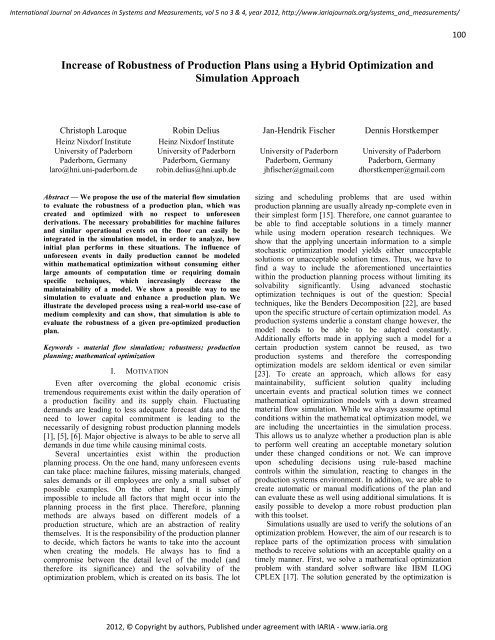c - IARIA Journals
c - IARIA Journals
c - IARIA Journals
You also want an ePaper? Increase the reach of your titles
YUMPU automatically turns print PDFs into web optimized ePapers that Google loves.
International Journal on Advances in Systems and Measurements, vol 5 no 3 & 4, year 2012, http://www.iariajournals.org/systems_and_measurements/<br />
Increase of Robustness of Production Plans using a Hybrid Optimization and<br />
Simulation Approach<br />
Christoph Laroque<br />
Heinz Nixdorf Institute<br />
University of Paderborn<br />
Paderborn, Germany<br />
laro@hni.uni-paderborn.de<br />
Robin Delius<br />
Heinz Nixdorf Institute<br />
University of Paderborn<br />
Paderborn, Germany<br />
robin.delius@hni.upb.de<br />
Abstract — We propose the use of the material flow simulation<br />
to evaluate the robustness of a production plan, which was<br />
created and optimized with no respect to unforeseen<br />
derivations. The necessary probabilities for machine failures<br />
and similar operational events on the floor can easily be<br />
integrated in the simulation model, in order to analyze, how<br />
initial plan performs in these situations. The influence of<br />
unforeseen events in daily production cannot be modeled<br />
within mathematical optimization without consuming either<br />
large amounts of computation time or requiring domain<br />
specific techniques, which increasingly decrease the<br />
maintainability of a model. We show a possible way to use<br />
simulation to evaluate and enhance a production plan. We<br />
illustrate the developed process using a real-world use-case of<br />
medium complexity and can show, that simulation is able to<br />
evaluate the robustness of a given pre-optimized production<br />
plan.<br />
Keywords - material flow simulation; robustness; production<br />
planning; mathematical optimization<br />
I. MOTIVATION<br />
Even after overcoming the global economic crisis<br />
tremendous requirements exist within the daily operation of<br />
a production facility and its supply chain. Fluctuating<br />
demands are leading to less adequate forecast data and the<br />
need to lower capital commitment is leading to the<br />
necessarily of designing robust production planning models<br />
[1], [5], [6]. Major objective is always to be able to serve all<br />
demands in due time while causing minimal costs.<br />
Several uncertainties exist within the production<br />
planning process. On the one hand, many unforeseen events<br />
can take place: machine failures, missing materials, changed<br />
sales demands or ill employees are only a small subset of<br />
possible examples. On the other hand, it is simply<br />
impossible to include all factors that might occur into the<br />
planning process in the first place. Therefore, planning<br />
methods are always based on different models of a<br />
production structure, which are an abstraction of reality<br />
themselves. It is the responsibility of the production planner<br />
to decide, which factors he wants to take into the account<br />
when creating the models. He always has to find a<br />
compromise between the detail level of the model (and<br />
therefore its significance) and the solvability of the<br />
optimization problem, which is created on its basis. The lot<br />
Jan-Hendrik Fischer<br />
University of Paderborn<br />
Paderborn, Germany<br />
jhfischer@gmail.com<br />
2012, © Copyright by authors, Published under agreement with <strong>IARIA</strong> - www.iaria.org<br />
Dennis Horstkemper<br />
University of Paderborn<br />
Paderborn, Germany<br />
dhorstkemper@gmail.com<br />
sizing and scheduling problems that are used within<br />
production planning are usually already np-complete even in<br />
their simplest form [15]. Therefore, one cannot guarantee to<br />
be able to find acceptable solutions in a timely manner<br />
while using modern operation research techniques. We<br />
show that the applying uncertain information to a simple<br />
stochastic optimization model yields either unacceptable<br />
solutions or unacceptable solution times. Thus, we have to<br />
find a way to include the aforementioned uncertainties<br />
within the production planning process without limiting its<br />
solvability significantly. Using advanced stochastic<br />
optimization techniques is out of the question: Special<br />
techniques, like the Benders Decomposition [22], are based<br />
upon the specific structure of certain optimization model. As<br />
production systems underlie a constant change however, the<br />
model needs to be able to be adapted constantly.<br />
Additionally efforts made in applying such a model for a<br />
certain production system cannot be reused, as two<br />
production systems and therefore the corresponding<br />
optimization models are seldom identical or even similar<br />
[23]. To create an approach, which allows for easy<br />
maintainability, sufficient solution quality including<br />
uncertain events and practical solution times we connect<br />
mathematical optimization models with a down streamed<br />
material flow simulation. While we always assume optimal<br />
conditions within the mathematical optimization model, we<br />
are including the uncertainties in the simulation process.<br />
This allows us to analyze whether a production plan is able<br />
to perform well creating an acceptable monetary solution<br />
under these changed conditions or not. We can improve<br />
upon scheduling decisions using rule-based machine<br />
controls within the simulation, reacting to changes in the<br />
production systems environment. In addition, we are able to<br />
create automatic or manual modifications of the plan and<br />
can evaluate these as well using additional simulations. It is<br />
easily possible to develop a more robust production plan<br />
with this toolset.<br />
Simulations usually are used to verify the solutions of an<br />
optimization problem. However, the aim of our research is to<br />
replace parts of the optimization process with simulation<br />
methods to receive solutions with an acceptable quality on a<br />
timely manner. First, we solve a mathematical optimization<br />
problem with standard solver software like IBM ILOG<br />
CPLEX [17]. The solution generated by the optimization is<br />
100







